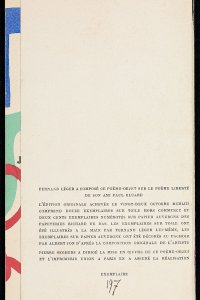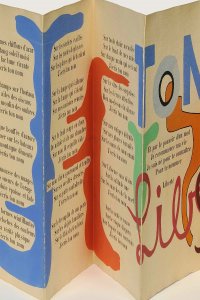Liberté, j'écris ton nom
Year: 1953
Author: Paul Éluard (1895 - 1952)
Artist: Fernand Léger (1881 - 1955)
Publisher: Pierre Seghers, éditeur
Bibliographical description
Description: Liberté, j'écris ton nom / Paul Éluard ; [illustrations de Fernand Léger] – Paris : Pierre Seghers, éditeur, 1953 – Leporello. : ill. ; 33 cm
Printer: Union à Paris (text) Albert Jon (illustrations)
Edition: 212 copies
This copy: Number 197 of 200 on Auvergne Richard de Bas.
Note: Concertina book
Bibliography: Bénézit 8-441 ; Monod 4214
Shelfmark: KW Koopm E 65
References
- Georges Bauquier, Fernand Léger: vivre dans le vrai. Paris, Maeght, 1987
- Paul van Capelleveen, Sophie Ham, Jordy Joubij, Voices and visions. The Koopman Collection and the Art of the French Book. The Hague, Koninklijke Bibliotheek, National Library of the Netherlands; Zwolle, Waanders, 2009
- Paul van Capelleveen, Sophie Ham, Jordy Joubij, Voix et visions. La Collection Koopman et l'Art du Livre français. La Haye, Koninklijke Bibliotheek, Bibliothèque nationale des Pays-Bas; Zwolle, Waanders, 2009
- Peter De Francia, Fernand Léger. New Haven, Yale University Press, 1983
- Paul Éluard, Œuvres Complètes. Paris, Gallimard, 1968
- Annick Lionel-Marie, Paul Éluard et ses amis peintres, 1895-1952. Paris, Centre Georges Pompidou, 1982


